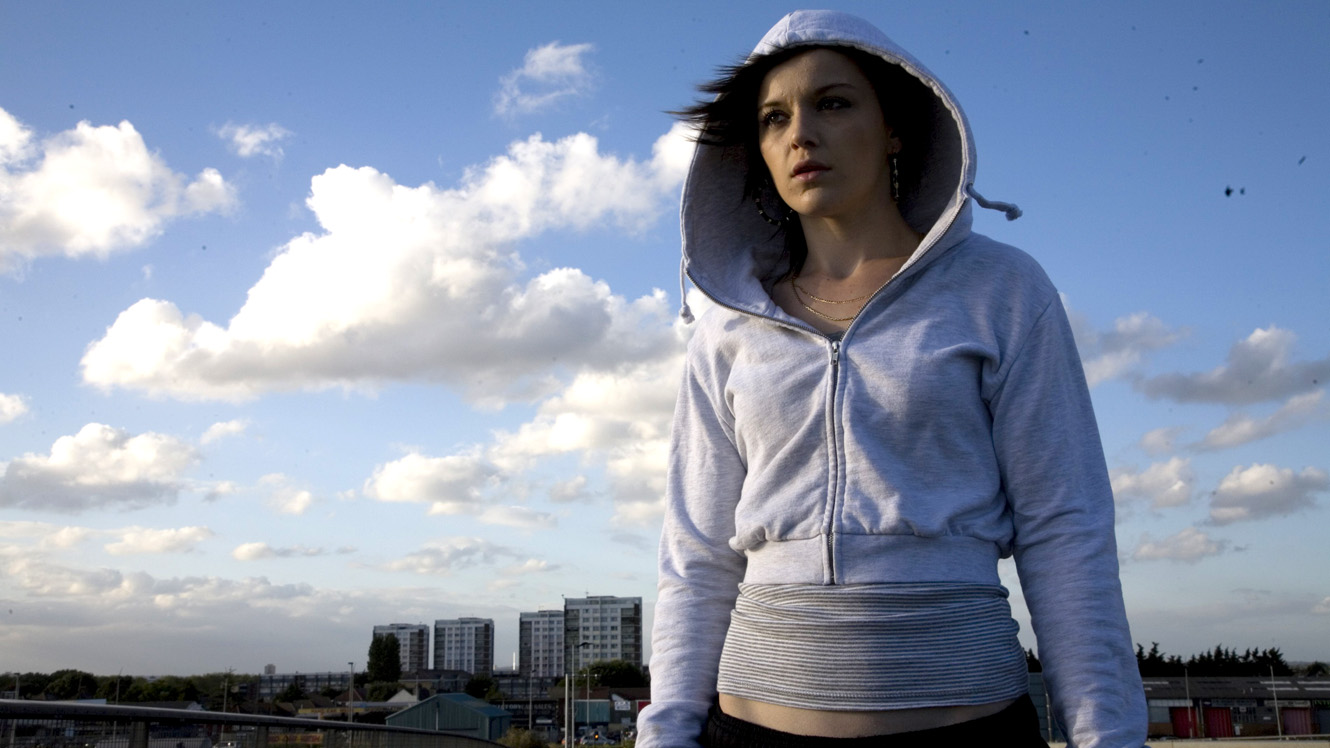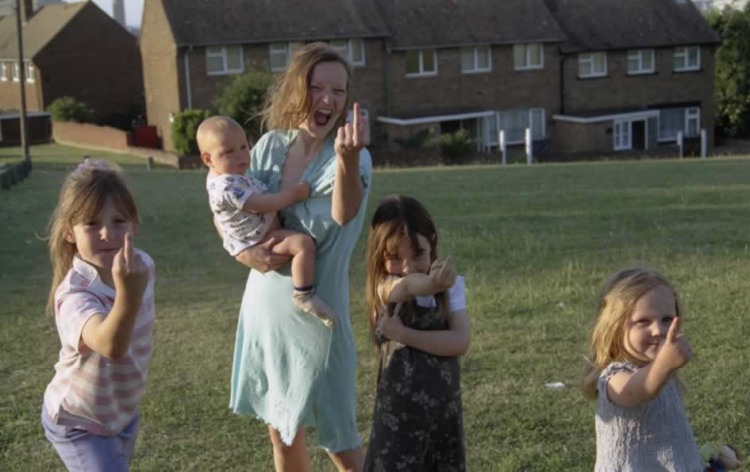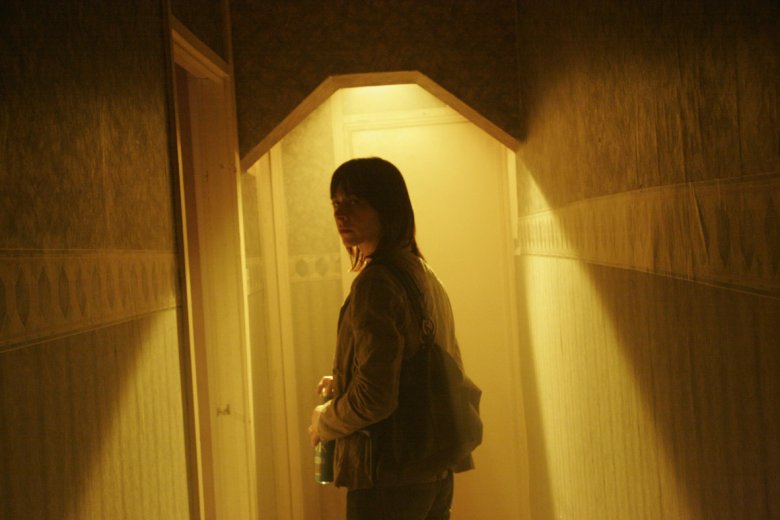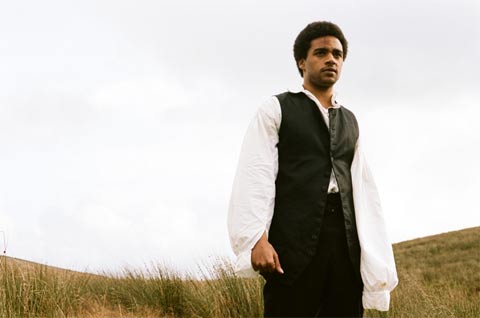This guest post written by Siobhan Denton appears as part of our theme week on Women Directors.
Andrea Arnold’s films largely focus on the female experience, predominantly that of young women transitioning into adulthood. These women often find this experience problematic, particularly when informed or defined through their relationship with the men around them. Fish Tank’s Mia establishes a formative, abusive relationship with the much older Conor, while Cathy Earnshaw, finding herself perpetually torn between both men and social status, is driven to physical illness in Wuthering Heights. While Mia is able to leave behind her experience with Conor, and her unsupportive family, she still finds her freedom through establishing a relationship with a man. While this male character is on equal terms with Mia, and their relationship thus appears to be far healthier, she still needs him in order to remove herself from her current environment.
American Honey’s Star (Sasha Lane) is, initially, similarly propelled into action through interaction with a male character. Jake (Shia LaBeouf), part of the magazine crew selling subscriptions managed by Krystal (Riley Keough), imparts a vision of a life filled with no responsibility. For Star, whose life currently consists of digging through dumpsters to find food with two young charges, Jake’s offer is difficult to turn down. Initially, she resists, feeling some level of responsibility towards her current life, despite its futility. Quickly though, she recognizes that these children, and indeed the domesticity that she is attempting to uphold despite the harassment she receives from the children’s father, is not her concern.
It is here then, that Arnold’s depiction of female desire and agency warrants praise. Star acts on her own wants and needs, and seeing Jake, acknowledges her longing. She consciously rejects the current trajectory of her life, and intentionally and purposefully seeks a new one.
Her meeting with Jake signals the life that Star seeks. First, she witnesses him travelling on the bus filled with the various adolescent members of the magazine crew. The pair lock eyes. Jake is surrounded by his fellow crew members, while Star holds the spoils of her latest dumpster search, young children beside her. Seeing the bus turn into a supermarket, Star implores the children to join her in visiting the store. Once inside, she watches Jake dance to Rihanna’s “We Found Love,” clambering up on the checkout counter to ensure that he’s caught Star’s attention. It is this version of Jake that Star finds entrancing; she seems to revel in his vicariousness and enjoys his physicality.
Take the scene in the parking lot, in which the pair almost face off as if battling one another. The camera constantly moves, weaving and bobbing around between the two as they edge towards and away from one another, not quite ready to trust each other’s intentions yet intrigued by what one another appear to represent. For Star, Jake represents a life lived without constraints, a life in which she has power and control over her own life. For Jake, Star seemingly represents an opportunity to indulge in his own desires.
Later, after spending more time with Jake, Star discovers that in fact, despite the image that he presents, he subscribes to the American Dream in the same way that everyone else does. He becomes disappointingly conventional, and in turn, loses his hold over her. Star has witnessed and lived the drudgery of domesticity and seeks an escape from it.
Jake tries to mold Star to his desires. He wants to have her, and to be with Krystal simultaneously without consequences. In training Star, he attempts to impart his money-making ways upon her, encouraging her to lie. She watches as he profusely insists to a potential customer of his desire to attend college and the subsequent need to sell subscriptions in order to do so. Jake expects Star to act in the same way, using any anecdote regardless of its validity in order to secure a sale. Notably, in training Star, he expects, and Krystal insists (when it is noted that Star is not yet making enough money) to secure sales through lies and blurred facts. This is the way in which Jake has found success, and to him, it is the only way. In teaching Star, Jake assumes the role of experienced, intellectual educator. He instructs Star in the ways in which he has previously found success, never offering Star the opportunity to prove her own worth in her own manner.
When Star, in an attempt to prove her worth, engages with a group of older men and agrees to travel back to their home, Jake immediately questions her actions. To Jake, Star’s actions demonstrate a need to be rescued. He arrives uninvited to the wealthy abode, aggressively insisting that Star join him in leaving. Star, left to her devices, has managed to secure an impressive sale and shows that away from Jake, she is more than capable of interacting with men and maintaining her own power dynamic. Jake struggles to accept this and chastises Star for her methods. It is after this pseudo-rescue that Jake and Star first consummate their burgeoning relationship. It is as if Jake feels the need to reassert his control and power over Star, unable to recognize that she is able to enact her own wants and needs and that she’s able to survive on her own terms.
Jake constantly insists on rescuing Star, particularly from situations that are of her own intentional making. Star agrees to offer her services to an oil worker for a substantial amount of money. There is no real sense that Star feels manipulated or coerced into agreeing to this transaction, but Jake, upon discovering the situation, once again acts aggressively. First, he asserts his masculine power by attacking the oil worker, then by questioning Star’s behavior and displaying his displeasure at her actions. We later discover that Jake regularly sleeps with the girls that he helps to recruit to the magazine crew, but he appears to insist on Star’s fidelity while not displaying any such intention himself.
It is in this moment that Star recognizes that Jake’s conventional nature is prohibiting the life that she has sought for herself. The imbalance of power that has existed cannot be corrected, while Jake still insists on performative gender stereotypes. At the narrative’s close, Jake gifts Star with a turtle. Star, retreating from the group, sets the turtle free, symbolically coinciding with her decision to allow herself to follow her own desires, rather than monitor them to cater to Jake’s needs.
Siobhan Denton is a teacher and writer living in Wales, UK. She holds a BA in English and an MA in Film and Television Studies. She is especially interested in depictions of female desire and transitions from youth to adulthood. She tweets at @siobhan_denton and writes at The Blue and the Dim.













